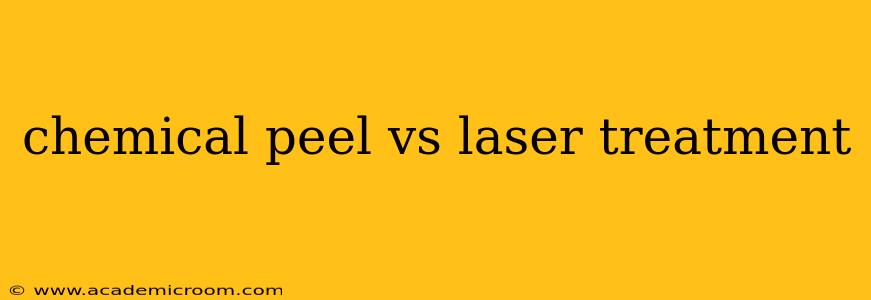Choosing between a chemical peel and laser treatment for skin rejuvenation can feel overwhelming. Both procedures aim to improve skin texture, tone, and reduce the appearance of wrinkles, acne scars, and age spots, but they achieve this through different mechanisms. This comprehensive guide will delve into the specifics of each treatment, highlighting their differences and helping you determine which option best suits your individual needs and goals.
What is a Chemical Peel?
A chemical peel involves applying a chemical solution to the skin, causing controlled damage to the outer layers. This controlled injury triggers the skin's natural healing process, leading to the growth of new, healthier skin cells. The depth of the peel determines the extent of improvement and the recovery time. Superficial peels target the epidermis (outermost layer), while medium and deep peels penetrate deeper into the dermis (second layer).
Types of Chemical Peels:
-
Superficial peels: These use mild acids like glycolic acid or salicylic acid, causing minimal discomfort and downtime. They're ideal for addressing minor imperfections like acne, mild hyperpigmentation, and fine lines.
-
Medium peels: These employ stronger acids such as trichloroacetic acid (TCA) and are more effective in treating moderate wrinkles, acne scars, and sun damage. Downtime is typically several days to a week.
-
Deep peels: These are reserved for significant skin damage and wrinkles and use phenol as the active ingredient. They offer dramatic results but involve a longer recovery period (weeks to months) and carry a higher risk of complications.
What is Laser Treatment?
Laser treatment uses concentrated beams of light to target specific skin layers. Different types of lasers target different skin concerns. The laser energy heats the skin, stimulating collagen production and improving skin texture. Some lasers also target pigment to reduce age spots and sun damage.
Types of Laser Treatments:
-
Ablative lasers: These lasers remove the outer layers of skin, promoting new collagen growth. They're effective for treating wrinkles, scars, and sun damage but involve significant downtime and potential for complications. Examples include CO2 and Erbium:YAG lasers.
-
Non-ablative lasers: These lasers penetrate the skin without removing the outer layers. They stimulate collagen production with less downtime and risk. Examples include IPL (intense pulsed light) and fractional lasers.
Chemical Peel vs. Laser Treatment: Key Differences
| Feature | Chemical Peel | Laser Treatment |
|---|---|---|
| Mechanism | Chemical exfoliation | Light energy to stimulate collagen |
| Depth of Action | Superficial, medium, or deep | Variable depending on the type of laser |
| Downtime | Varies greatly depending on peel depth | Varies greatly depending on laser type |
| Cost | Generally less expensive than laser treatments | Generally more expensive than chemical peels |
| Treatment Areas | Face, neck, hands | Face, neck, hands, other areas |
| Suitable for | Acne, mild hyperpigmentation, fine lines, sun damage | Wrinkles, scars, sun damage, hyperpigmentation, vascular lesions |
Which Treatment is Right for Me?
The best treatment depends on your specific skin concerns, skin type, and desired outcome. Factors to consider include:
-
Severity of skin issues: Mild imperfections may respond well to a superficial chemical peel, while deeper wrinkles or scars may require a laser treatment.
-
Downtime tolerance: If you have limited downtime, a superficial peel or non-ablative laser might be better.
-
Budget: Chemical peels are typically less expensive than laser treatments.
-
Skin type: Some skin types are more prone to complications with certain treatments. A consultation with a dermatologist is crucial.
What are the potential side effects of chemical peels?
Potential side effects of chemical peels can include redness, swelling, crusting, and changes in skin pigmentation. The severity depends on the type of peel. Deep peels carry a higher risk of scarring and infection.
What are the potential side effects of laser treatments?
Potential side effects of laser treatments include redness, swelling, bruising, crusting, and changes in skin pigmentation. Ablative lasers carry a higher risk of complications than non-ablative lasers.
How long does recovery take for a chemical peel?
Recovery time for a chemical peel varies significantly depending on the depth of the peel. Superficial peels require minimal downtime, while deep peels can take weeks or even months to fully heal.
How long does recovery take for laser treatment?
Recovery time for laser treatment also depends on the type of laser used. Non-ablative lasers typically involve minimal downtime, while ablative lasers can result in several days or weeks of healing.
Are chemical peels and laser treatments safe?
Chemical peels and laser treatments are generally safe when performed by qualified and experienced professionals. However, like any medical procedure, they carry potential risks and side effects. It's crucial to choose a board-certified dermatologist or plastic surgeon.
Ultimately, the decision of whether to choose a chemical peel or laser treatment should be made in consultation with a dermatologist. They can assess your skin, discuss your goals, and recommend the most appropriate and effective treatment plan for you. Remember, healthy skin requires ongoing care, and these treatments are often part of a broader skincare regimen.
